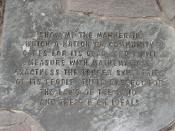3terms:
Fauxbourdon
Falsobordone
Passus durisculus (rising and falling chromatic lines-Dido etc)
Fauxbourdon:
The 15th century technique of composition, employed in short pieces or sections within longer pieces. Two voices are enotated, the upper a cantus prius factus (usually sacred) an octave higher than ordinary plainchant, the lower forming sixths and octaves below. The words faux bourdon or some variant thereof appear at the beginning of the piece or section, usually near the lower part. (This label may be lacking in some copies.) In the earliest and most widely accepted method of realization, a third voice paralleling the upper part at the fourth below is added in performance. Thus three voices sound where parts for only two are written out. (Later, made into extra two voices, worked out from the lower part: one alternating thirds and fifths below, beginning and ending with a unison or octave; the other alternating thirds and fourths above, beginning and ending with a fifth.)
The earliest occurrence of the term faux bourdon inscribed on a musical composition is in the older section (finished ca.1430) of I-Bc Q15, on the last item of Dufay's Missa Sancti Jacobi, the communion "Vos qui secuti estis me." Only a few compositions from outside the 15th century were originally designated faux bourdon, although theorists of the next several centuries mention the term, increasingly confusing it with falso bordone.
Although present knowledge of fauxbourdon necessarily rests in large part on written compositions, the technique was also used in extemporizing harmonizations of plainchant. (extemporize: improvise/compose, speak (esp)! or perform) . This practice was referred to by G. Monachus and probably implied by a musical example given by Tinctoris in the late 15th century. In such an improvisation, the pre-existing melody is in the tenor, whereas in written fauxbourdon it is in the upper...


